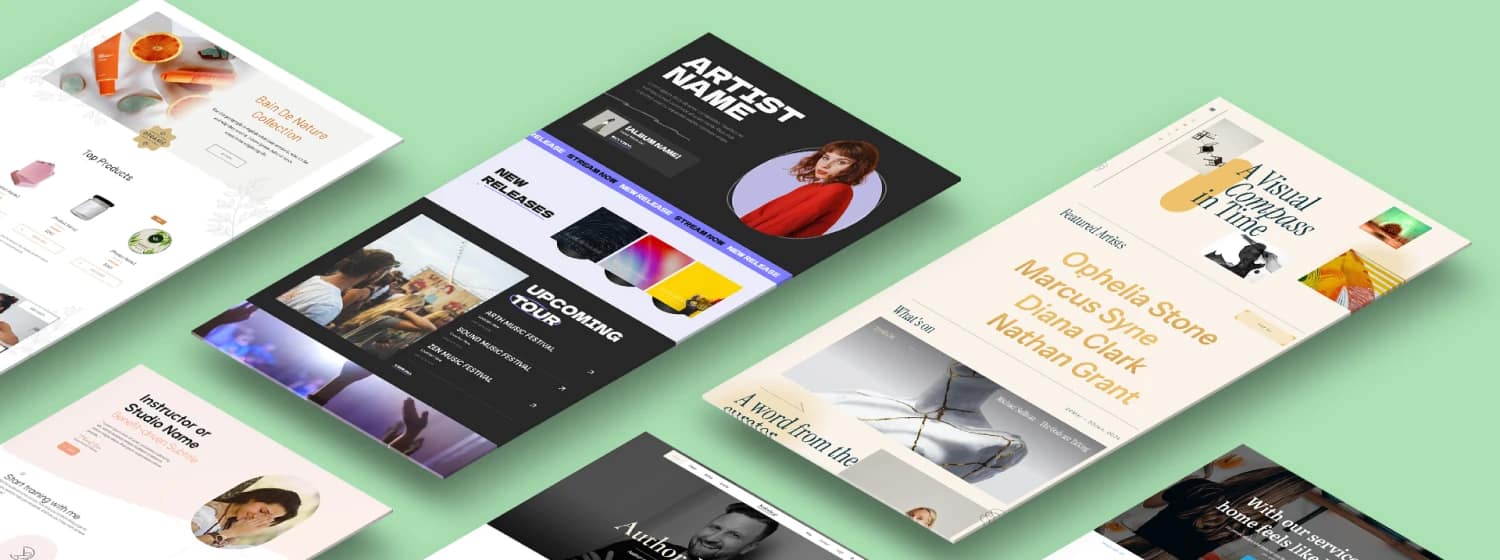🎯 TL;DR: What Are the Best Marketing Tips for Artists Who Want to Sell More Art Online?
Looking for marketing tips for artists that actually help you get noticed and make sales? Here’s the quick version: success doesn’t come from doing everything — it comes from doing the right things consistently.
Here’s the system that works in 2025:
Create a professional artist website that builds trust and makes buying easy
Use 1–2 social platforms to connect (not just post) and share stories, not just products
Build an email list so you can talk directly to people who love your work
Price your art clearly and fairly — no guessing or undercharging
Blend online and offline marketing to reach real buyers and collectors
This guide answers the 10 most important questions artists ask about building visibility, trust, and a sustainable income from their work.
When I’m not writing or knee-deep in strategy work, I’m making something — sketching, painting, experimenting. My background is in visual arts and communication, so I’ve seen what it takes to succeed in this space. And I’ll tell you now: it’s not just about “sharing your work” and hoping someone stumbles across it.
Because in today’s landscape? That’s a losing game.
The internet is noisy. The platforms are crowded. And even the most talented artists are getting buried by the algorithm. In fact, according to my research, 41.5% of artists say they struggle to find customers online, and 40% of crafters believe algorithm changes directly impact their sales.
So if you’ve been posting here and there, trying out Etsy, or starting a website that never quite launched — you’re not failing. You’re just operating without a structure. And without a system, it’s easy to burn out and harder to believe your work will ever get seen.
That’s why this guide exists.
Inside, I’ll walk you through the 10 most common questions artists ask when they’re finally ready to say, “Okay — I’m done winging it. Let’s make this real.”
We’ll cover:
- How to build a clean, professional online presence that does more than look good
- How to market your work without becoming a full-time content machine
- How to actually get your art in front of the right people — and get paid for it
This isn’t about hype. It’s about helping your work reach the people it was made for — consistently, sustainably, and without losing the joy that got you here in the first place.
You’ve waited long enough. Let’s build something that lasts.
What Are the Best Marketing Tips for Artists in 2025?
Below are the 10 questions I hear most from artists who are serious about growing their visibility and making real sales. Click any one to jump to the detailed strategy.
Think of your brand as more than just a logo or color palette — it’s the feeling people get when they encounter your work.
Start with your “why” — what drives you to create. Then shape that into a consistent story you can reflect across your artist website, your bio, your portfolio, and even your captions.
This isn’t about being flashy. It’s about clarity. When people get what you’re about, they remember you — and that’s one of the most underrated marketing tips for artists.
Start with your own website. That’s home base.
It doesn’t need to be fancy, but it needs to be yours — with built-in e-commerce (for originals, prints, or downloads) and a way for people to contact you.
Marketplaces like Saatchi Art or Society6 can give you a boost, but your real growth happens when you’re not relying on someone else’s platform.
You don’t need a massive portfolio or perfect homepage — but you do need a clean layout, high-quality images, and a site that works on mobile.
Your artist website should include the basics: Home, About, Gallery/Shop, and Contact. Add an email opt-in when you can.
This is one of the most important marketing tips for artists: own your space before you rent someone else’s (like social).
Ah yes, the burnout machine.
You don’t have to be on every app. Pick one or two platforms where your audience actually spends time. Post behind-the-scenes content, time-lapses, your messy desk — let people into your process.
The goal isn’t to go viral. It’s to build connection.
Social media marketing for artists should feel like an extension of your practice — not a second job.
People don’t just buy art. They buy meaning, emotion, story.
Share what a piece represents. What inspired it. How long it took. What it helped you process.
When you talk about your work like this — through captions, blog posts, email, or even a note on the packaging — people feel more connected.
That emotional bond? That’s what turns browsers into buyers.
There’s no single magic formula, but here’s the truth: underpricing isn’t humble — it’s confusing.
Start with a formula: materials + time + profit margin. Then look at other artists at your level.
But whatever you land on, stick with it. Consistency builds trust. When your art pricing is clear, people are more likely to buy — and come back.
Relationships don’t start with “Hey, buy my art.” They start with connection.
Support other artists. Show up at local events. Share stories from collectors who love your work.
Testimonials are powerful — sprinkle them into your site and socials. Real connection is the ultimate art marketing strategy because people support people they trust.
Absolutely — especially if you want to build local visibility and trust.
Online marketing brings reach. In-person events bring emotion. People see your work, talk to you, and remember you.
Plus, you can collect email addresses and direct traffic back to your site.
Think of these events as lead generation with a personal touch.
Email is one of the few places you’re not at the mercy of an algorithm.
Start by offering something valuable — like early access to new pieces or a free behind-the-scenes PDF.
Send regular updates that feel human: show your work, talk about your process, announce new drops.
If social is about reach, email is about depth.
Start small, but start consistently.
Enter a competition. Join a local group. Share progress pics. Collaborate. Pitch a blog.
You don’t need a massive launch — you need movement. The best marketing tip for new artists?
Visibility beats perfection. You can tweak the strategy later — but first, let people see you.
Why “Just Put Yourself Out There” Is the Worst Marketing Advice for Artists
I’ve heard it. You’ve heard it.
“Just put yourself out there.”
It sounds bold. You know, like the first step toward something big.
But once you’ve posted your work a dozen times and all you’re getting back is silence (or likes from your high school friends), that advice starts to lose its shine.
I’ve been there.
That Etsy shop I launched in a late-night whirlwind of courage?
Still says “Last updated: 2022.” (I eventually took it down)
The problem isn’t that we’re lazy or unserious. It’s that a lot of us are flying blind. Most artists were never taught how to market what they create. We were told to keep showing up and somehow, someday, it would all make sense.
But it doesn’t. Not without a system.
Visibility without connection is just noise.
And that noise will drain you.
70% of creatives in media and marketing report burnout — a rate far higher than in most industries.
Even in the booming creator economy, nearly half of full-time creators say the pressure to post everywhere causes content fatigue.
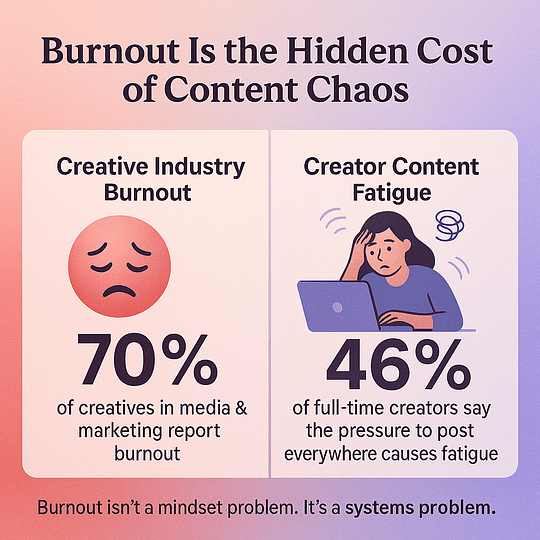
What Happens When You Don’t Market Your Art… Even If You’re Brilliant
Your work stays invisible to the very people it was meant for. You lose momentum, clarity, and confidence not because you’re untalented, but because no one knows you’re here.
“But my work should speak for itself.”
It might. But it still needs to be found. The result? Missed opportunities. Discouragement. Creative burnout.
You don’t need to shout. You need a structure that supports your rhythm — and this guide will help you build it.
So, if you’re feeling scattered, tired, and stuck: you’re not broken. You’re just trying to grow something in soil that was never built to support it.
What does that look like in real life?
But you are.
You’re just doing it without a framework and that’s what this guide is here to give you.
Because real connection (the kind that leads to loyal fans and actual sales) doesn’t happen by accident.
It happens by design.
So let’s design it intentionally.
Marketing Tips for Artists That Actually Work in 2025
If you want your art to be seen, remembered, and bought, you need more than talent. You just need structure. These marketing tips for artists are designed to help you build a system that connects your creative work with the people who are already looking for it.
This isn’t about turning into a salesperson or chasing trends. It’s about shaping your visibility in a way that feels aligned, intentional, and sustainable; so you can grow your audience without burning out.
Ready to shift from scattered effort to focused momentum? Let’s break it down, one strategy at a time.
1. Define Your Artistic Brand and Unique Identity
If someone saw your work without your name on it, would they know it was yours?
This is the heart of your artistic brand: the visual, emotional, and narrative thread that ties everything together. It’s not about forcing a persona. It’s about amplifying what’s already there.
Start with a simple self-audit:
- What themes or subjects show up again and again in your work?
- What medium, tone, or process feels most like you?
- What emotions do you want someone to feel when they see your art?
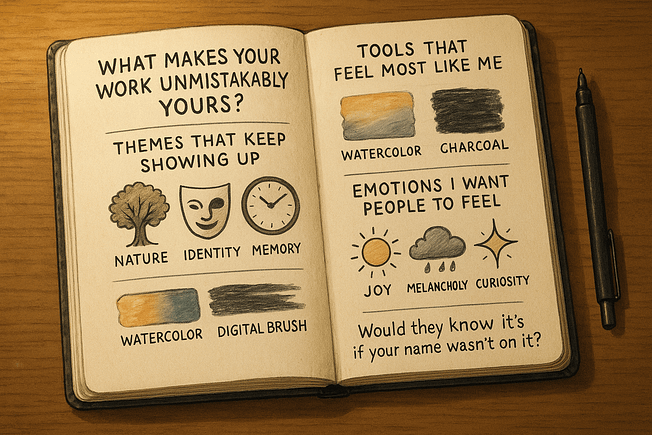
Once you have those answers, begin crafting your art brand identity across every touchpoint – your website, Instagram bio, About page, even your email footer.
Consistency doesn’t mean repetition. It means resonance. The more aligned your visual and narrative presence is, the easier it becomes for people to remember, recognize, and trust your work.
🛠️ Tip:
Use Thrive Architect’s brand color presets and layout templates to build a cohesive online presence that reflects your unique style without spending hours designing from scratch.
2. Ditch the Middleman and Sell Your Art Online Yourself
If your art is only available through third-party platforms, you're building someone else’s business and not your own.
One of the smartest marketing tips for artists in 2025 is this: create a home you control. That means building your own website with built-in sales functionality. It gives you more profit, more freedom, and more long-term stability.
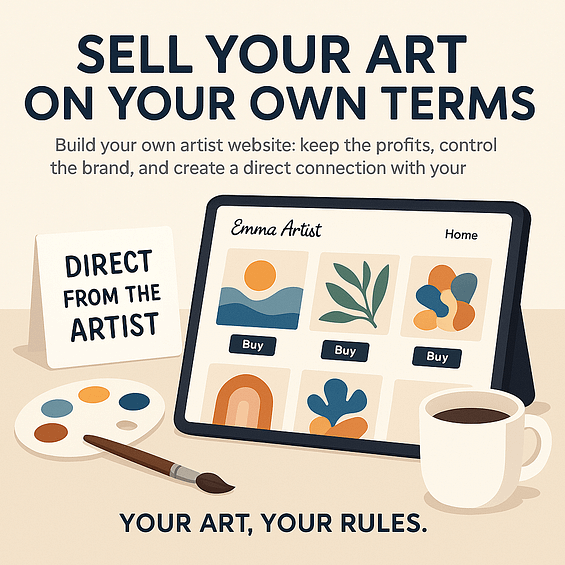
Start with the essentials:
You can still list on marketplaces like Gumroad, Etsy, Saatchi or Society6 — just be intentional. Choose one or two platforms that genuinely align with your audience and artistic goals. Then use your website as the anchor for everything.
🎯 It’s time to give your art the platform it deserves.
If you’ve ever stared at a blank screen wondering how to translate your vision into a website, or felt stuck trying to piece together your online presence with tools that weren’t built for creatives… it’s time to make a change.
We’ve worked with enough artists to know: ✨ You need tools that respect both your process and your professionalism. ✨ You want your website to feel like your studio — curated, intentional, and built to showcase your best work.
That’s exactly what the Thrive Suite was designed to do.
- Use Thrive Architect to build a storytelling-first website that’s visually striking and easy to update
- Design a clean, conversion-focused portfolio with Thrive Theme Builder — no coding required
- 🖼️ Tip: Use Thrive Theme Builder’s Gallery template to design a high-converting homepage in hours, not weeks. It’s built for creators who want beauty and performance
- 📖 Curious what that looks like? Check out our guide to building an artist homepage that actually converts.
Your art doesn’t need to shout to be seen but it does need the right platform.
Let’s build one that works as hard as you do.
3. Build a Professional Online Presence That Works for You 24/7
Once you’ve built a home for your art, the next step is making sure it’s more than just a digital gallery. It should work for you.
Your online presence isn’t just where people view your art. It’s where they decide if they trust you. It’s where commissions are born, collaborations begin, and collectors make up their minds.
If your site looks unfinished, confusing, or outdated, visitors will quietly leave… even if your work is incredible.
✅ The Must-Have Pages for a Trustworthy Artist Website
- Home: A quick, compelling snapshot of who you are and what you create
- About: Tell your story, process, and purpose in your own words
- Gallery or Shop: Showcase your best pieces with clarity and intention
- Contact: Make it easy for anyone – collector, press, curator – to reach out
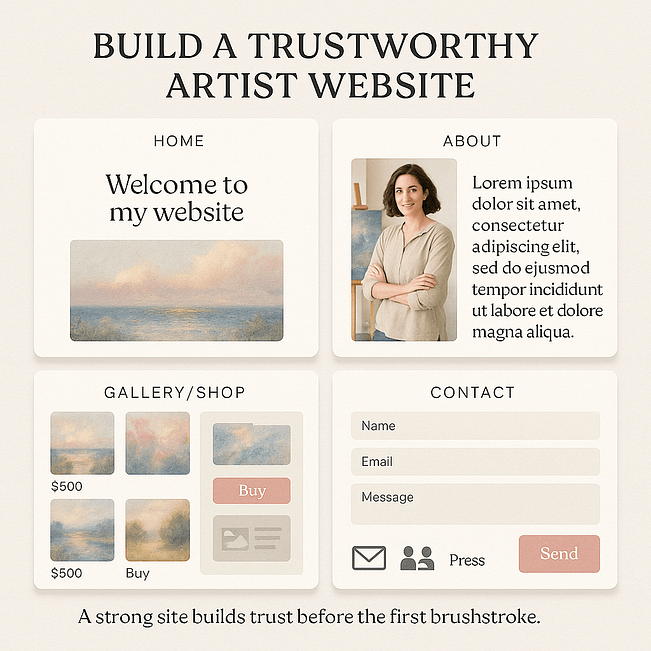
Don’t overlook the extras that build confidence:
Your goal? When someone lands on your site, they should feel like they’ve stepped into your creative world — and know exactly what to do next.
📘 Need a walkthrough?
4. Use Social Media to Create Connection, Not Just Content
You don’t need to be everywhere. You just need to be where it matters.
The point of social media isn’t to “go viral.” It’s to build trust, show your process, and create emotional connection. That’s what makes someone follow, share, or buy from you down the line.
Pick one or two platforms that make sense for your audience *and* your energy. If you’re a visual artist, Instagram or Pinterest might serve you well. If you’re more narrative-driven, try YouTube or even a Substack-style blog for long-form storytelling.
Once you’ve chosen your platforms, focus on content that feels personal, not performative:
- Behind-the-scenes of your process
- The story behind a piece
- Studio updates or sketchbook entries
- Your wins, your struggles, your art life
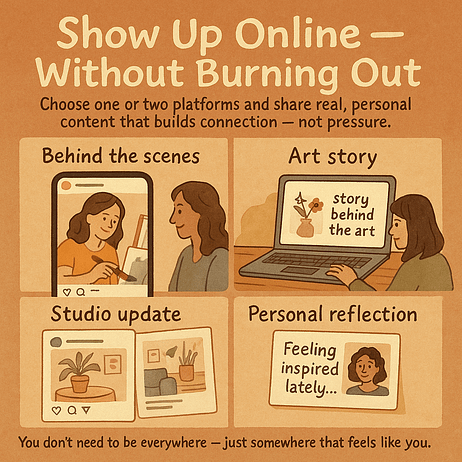
Don’t overthink it. The more consistent and real you are, the more people connect.
📌 Tip:
Add your social feeds directly to your site using a tool like Smash Balloon — it’ll make your site feel alive and current. (We even have a guide here)
📚 Want help developing a voice that sells without selling out? Read our guide to personal branding for creators and entrepreneurs.
5. Share the Stories That Make Your Art Worth Buying
When it comes to art (in all its forms), people aren’t just looking to buy a product. They’re buying into a meaning, emotion, or connection.
If you’ve ever had someone say, “There’s something about this piece that just speaks to me,” you already know the power of storytelling. It bridges the gap between your creative world and someone else’s lived experience.
But the story only works if you tell it.
Start simple. Every time you finish a project, ask yourself:
- What inspired this piece?
- What were you feeling while making it?
- What do you hope someone feels when they see it?
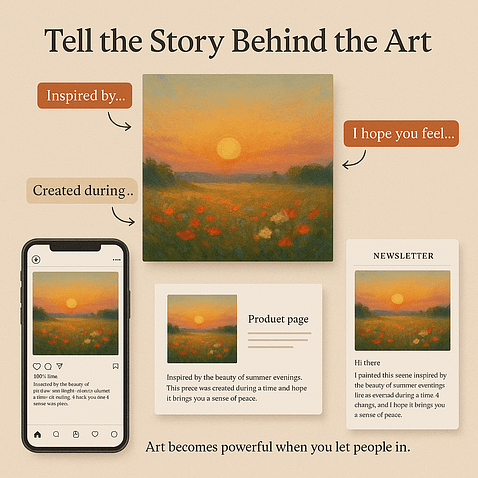
Turn those reflections into a short story you can use across platforms:
The goal isn’t to write an essay. It’s to invite people in and make them feel something real. While also getting them to buy or interact with your brand.
🎨 Tip:
Use Thrive Architect’s storytelling block or bio section to weave narrative into your pages without overwhelming your layout. Just enough to spark curiosity and emotion.
6. Price Your Work With Confidence and Clarity
Pricing is where a lot of artists stall. I would know.
It’s not because we don’t believe in their art, but because we fear that no one else will.
I’ve seen it, felt it, lived it. That weird ache in your chest when you type in a number and wonder, “Is this too much? Or worse… not enough?”
But here’s the thing most people won’t say:
Pricing isn’t just about numbers. It’s about narrative.
The price you set tells a story: about how you see yourself, how much you value your work, and what kind of collector you’re calling in.
To get that story right, start with a value-based approach. Factor in:
- Your materials and production costs
- Your time, technique, and lived experience
- The emotional depth or symbolic meaning of the piece
- The strength of your brand and presentation across channels
Then, and this is key, stay consistent.
If your painting is $850 on your website but $600 on a third-party marketplace, you’re not giving buyers a deal… you’re giving them doubt.
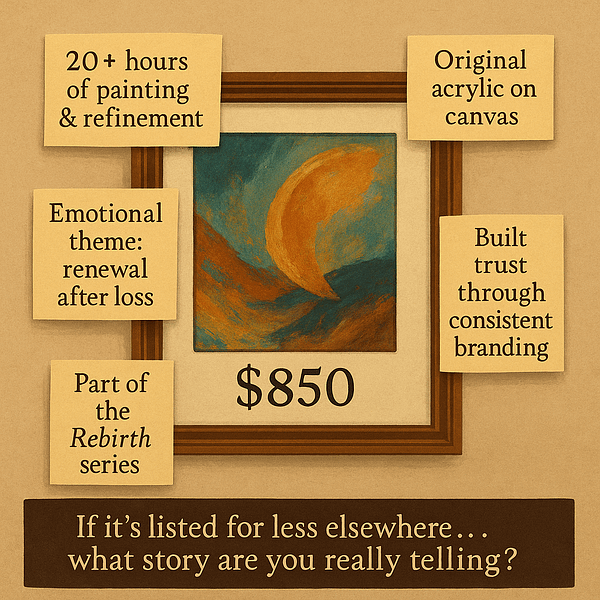
You deserve to be paid not just for what you made but for what it means.
📘 Tip:
Still second-guessing your numbers? Check out our guide to common pricing mistakes and how to avoid them. It’s practical, empowering, and made to help you breathe a little easier.
7. Build Relationships That Fuel Growth
Behind every successful artist is a network – collectors, collaborators, curators, and creative friends who keep the momentum going.
Marketing isn’t just about visibility. It’s about credibility. And that comes from people talking about your work, not just you.
Here’s how to build those kinds of connections:
- Say yes to collaborations that align with your values or expand your reach
- Join local or online artist communities and actually show up
- Nurture relationships with past collectors. A kind note or studio update goes a long way
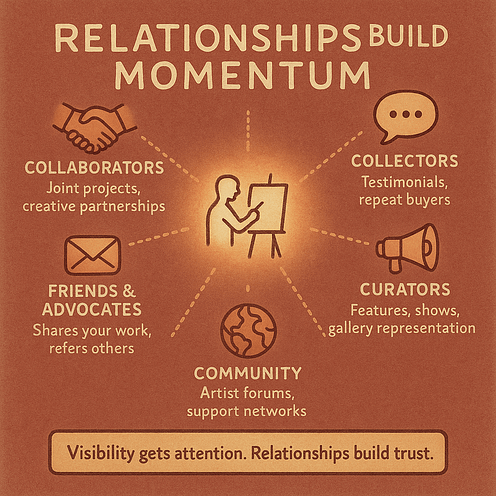
And please, don’t be shy about testimonials.
Ask happy clients or collectors to share a sentence or two about why they bought your work and how it made them feel. Then display those testimonials proudly on your site. It creates social proof and tells future buyers, “You’re in good company.”
💬 Tip:
Need ideas for collecting and using reviews effectively? Here’s our guide to testimonial marketing that builds trust (and boosts sales).
8. Promote Your Work Offline (Yes, It Still Works)
In a world where everyone’s chasing algorithms and reach, here’s an underrated truth: the most meaningful marketing often happens face-to-face.
There’s something sacred about seeing art in person. The texture. The scale. The energy it gives off in a room. No photo can replicate that and no Instagram scroll will ever match the moment someone locks eyes with your work and *feels* something.
That’s why offline opportunities still matter in 2025; not just for exposure, but for genuine connection.
If you haven’t already, explore ways to put your work in the real world:
- Join local art fairs, open studios, or pop-up markets – where people are already in a mindset to discover and support creatives
- Offer commissions or exclusive pieces at community events – especially ones tied to cultural or seasonal moments
- Donate a piece for a charity auction or exhibit – you’d be surprised how much goodwill (and word-of-mouth) this can spark
- Partner with local cafes, shops, or co-working spaces – let your work hang where people gather and talk
But don’t treat these events as isolated moments.
Bring a small stack of postcards with a QR code to your site, a sign-up form for your email list, or even a giveaway to collect names and contacts.
Every interaction is a seed.
Offline may start the conversation but your digital presence will keep it going.
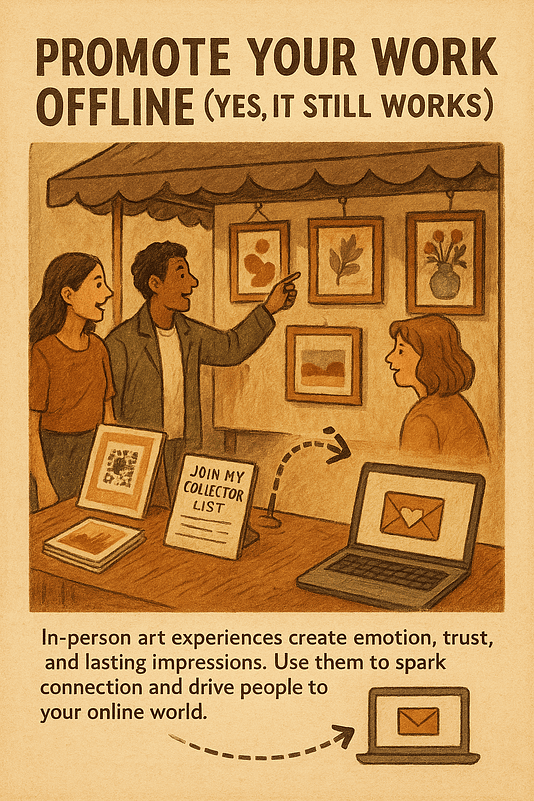
🛠️ Pro Tip:
Create a simple “Event Sign-Up” page using Thrive Architect or Thrive Leads so you can capture interest on the spot, even from someone just Browse.
9. Use Email to Stay Top of Mind With Your Fans
If social media is a crowd, email is a conversation.
Your email list is the one place where you control the relationship. No algorithms. No distractions. Just you, your art, and people who’ve asked to hear from you.
Here’s how to start:
- Create a simple opt-in – a behind-the-scenes look, a free wallpaper, or early access to new work
- Make it visible across your site and in person (QR codes work great at events)
- Set up an automated welcome email that introduces you and what they can expect
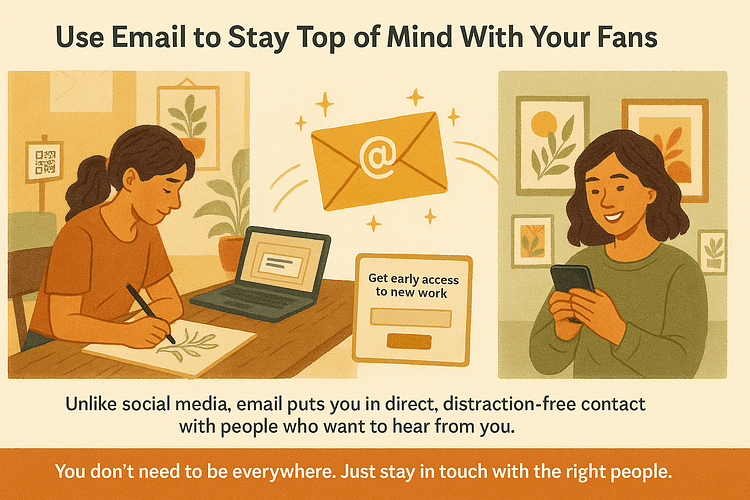
From there, you can share collection launches, studio updates, or even process notes. You don’t have to write weekly newsletters — just keep the connection alive.
🛠️ Tool Tip:
Use Thrive Leads for your opt-in form, and set up automated email flows with your email marketing platform of choice. A warm list is a powerful one.
10. Get Noticed as a New Artist Without Selling Your Soul
When you're just starting out, it can feel like you're whispering into the void while everyone else is shouting with a megaphone.
But you don’t need to go viral. You just need to start where your people already are and show up with intention.
Here’s how to build momentum without losing yourself:
- Submit to a few well-chosen art competitions – many are free and offer real visibility
- Get your work featured on PR-friendly art platforms or curated newsletters
- Run a strategic giveaway (like a print or custom sketch) to build buzz and collect emails
- Join niche communities – small but active groups on Discord, Slack, or artist-run forums can become your first real fanbase.
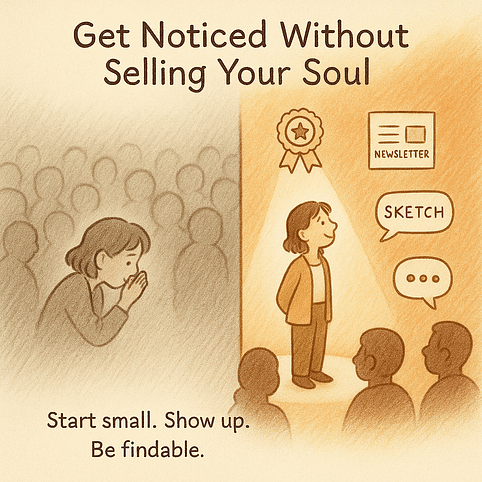
Remember, your first 100 true fans are more valuable than 10,000 passive likes.
🧠 Mindset Tip:
You don’t need to be everywhere. You just need to be findable, memorable, and consistent where it counts.
🙋 Artist Marketing FAQ: Real Answers to Real Questions
💡 Use this section as a toggle-style accordion or dropdown box for a clean, skimmable experience.
Your site should have five essentials: Home, About, Gallery, Contact, and an Email Opt-in. Bonus points for a clear CTA like “Shop Originals” or “Join My Studio List.” Clean design and mobile responsiveness also go a long way.
Yes, but it takes strategy. Focus on search engine optimization (SEO), email marketing, and curated marketplaces to get eyes on your work. You’ll need to be intentional with your content and build discoverability in other ways.
Offer something small but valuable: a behind-the-scenes look, a digital sketch, or early access to your next release. Then promote it everywhere: your homepage, Instagram bio, checkout pages, and even in-person events.
No. You’re an artist, not a content robot. Pick one platform that aligns with your style and audience, and commit to showing up there with intention. Consistency beats exhaustion every time.
If it’s valuable, personal, or exciting, share it. Instead of pushing constant “buy now” posts, mix in behind-the-scenes content, collector stories, or new project updates. Keep it relational, not transactional.
Use a print-on-demand service (like Printful or Gelato) or add a digital shop to your website with automated delivery. Make sure your buyers know what they’re getting; clear mockups and file previews help.
If you want scalable income, offer both. Originals create prestige and exclusivity. Prints and downloads make your work accessible to a wider audience. They serve different goals and both are valid.
Ideally? Do both. Marketplaces give you visibility, especially early on. But your own website gives you full control, brand presence, and long-term credibility.
🔁 Marketing Tips for Artists: Art That Connects Is Art That Sells
At the end of the day, marketing your art isn’t about chasing clout or posting until your hands cramp. It’s about building a creative practice that supports both your vision *and* your visibility.
The truth? The most successful artists aren’t always the most talented; they’re the most consistent. They’ve figured out how to show up with intention, tell their stories, and invite people into their world without losing themselves in the process.
You don’t need to go viral.
You don’t need a million followers.
You need a system. Something that works quietly in the background while you create. Something that helps your work reach the right people without draining the life out of you.
That’s what this guide is about. Shifting from chaos to clarity. From random visibility to intentional connection.
And if you’re ready to take that next step…
🎯 It’s time to turn your art into a living, breathing business.
With Thrive Suite, you can:
- Build a storytelling-first website that captures attention and creates trust with Thrive Architect
- Design a portfolio that reflects your voice and style using Thrive Theme Builder
- Grow a loyal, engaged audience with Thrive Leads, no algorithm required
Your art deserves more than likes. It deserves longevity, ownership, and a platform that works as hard as you do.
Let’s make that happen.

